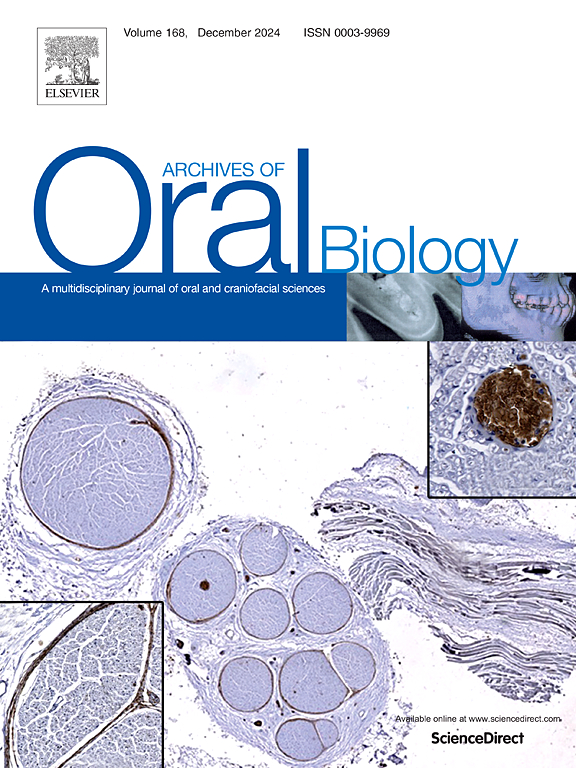口腔黏膜下纤维化的发病机制研究综述
IF 2.1
4区 医学
Q2 DENTISTRY, ORAL SURGERY & MEDICINE
引用次数: 0
摘要
目的口腔黏膜下纤维化(OSMF)是一种进行性口腔疾病,具有潜在的恶性。本文旨在探讨OSMF发病机制及其恶性转化为口腔癌的关键机制,重点关注相关细胞、生长因子和信号通路的作用,并详细介绍各通路内的顺序事件及其相互联系。DesignA使用PubMed、Scopus、谷歌Scholar和SciFinder等数据库进行全面的文献检索,以确定与OSMF和口腔癌相关的受影响细胞、途径和细胞机制。结果本文阐述了OSMF通过肌成纤维细胞激活的信号通路。它强调了关键细胞参与者的功能改变,包括上皮细胞、内皮细胞、免疫细胞和成纤维细胞。通过揭示参与OSMF发生、发展及口腔癌恶性转化的特定生长因子(TGF-βs、PDGF、FGF、VEGF、CTGF)和PI3K/AKT、JAK/STAT、WNT/β-catenin、NF-кB等信号通路,增强了对OSMF病理生理的认识。结论本综述在信号通路中发现了潜在的治疗靶点和生物标志物,主要是TGF-β和PI3K/AKT,它们调节OSMF中成纤维细胞的活化、炎症、活性氧的产生、胶原的合成和降解,从而进一步导致口腔癌的发生。为了开发针对特定生物标志物的新疗法,有必要更深入地了解这些信号级联反应。本文章由计算机程序翻译,如有差异,请以英文原文为准。
Elucidating the pathogenesis of oral submucous fibrosis: A comprehensive review
Objective
Oral submucosal fibrosis (OSMF) is a progressive and potentially malignant disorder of the oral cavity. This review aims to explore the key mechanisms underlying OSMF pathogenesis and its malignant transformation to oral cancer, focusing on the role of associated cells, growth factors, and signaling pathways, by detailing the sequential events within each pathway and their interconnections.
Design
A comprehensive literature search was conducted using databases such as PubMed, Scopus, Google Scholar, and SciFinder to identify affected cells, pathways, and cellular mechanisms associated with OSMF and oral cancer.
Results
This review elaborates the signaling pathways responsible for the progression of OSMF through myofibroblast activation. It highlights the altered functionality of key cellular players, including epithelial, endothelial, immune cells, and fibroblasts. It also enhances the understanding of OSMF pathophysiology by revealing the specific growth factors (TGF-βs, PDGF, FGF, VEGF, CTGF) and signaling pathways such as PI3K/AKT, JAK/STAT, WNT/β-catenin, and NF-кB, that are involved in the initiation and progression of OSMF and its malignant transformation to oral cancer.
Conclusion
This review identifies potential therapeutic targets and biomarkers within signaling pathways, mainly TGF-β and PI3K/AKT, that regulate fibroblast activation, inflammation, reactive oxygen species generation, collagen synthesis, and degradation in OSMF, which further leads to oral cancer development. In order to develop new treatments that target particular biomarkers, a deeper understanding of these signaling cascades is necessary.
求助全文
通过发布文献求助,成功后即可免费获取论文全文。
去求助
来源期刊

Archives of oral biology
医学-牙科与口腔外科
CiteScore
5.10
自引率
3.30%
发文量
177
审稿时长
26 days
期刊介绍:
Archives of Oral Biology is an international journal which aims to publish papers of the highest scientific quality in the oral and craniofacial sciences. The journal is particularly interested in research which advances knowledge in the mechanisms of craniofacial development and disease, including:
Cell and molecular biology
Molecular genetics
Immunology
Pathogenesis
Cellular microbiology
Embryology
Syndromology
Forensic dentistry
 求助内容:
求助内容: 应助结果提醒方式:
应助结果提醒方式:


